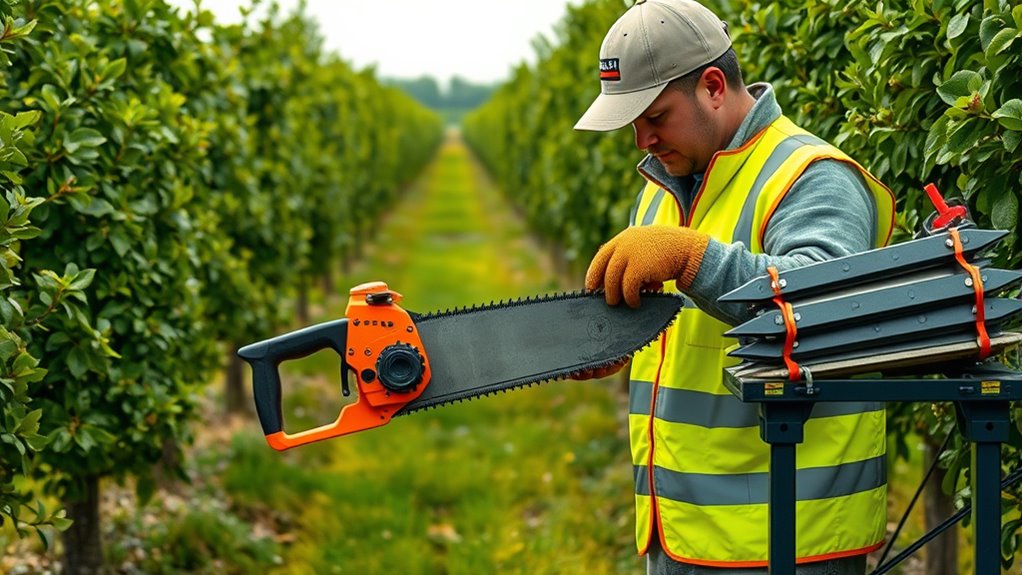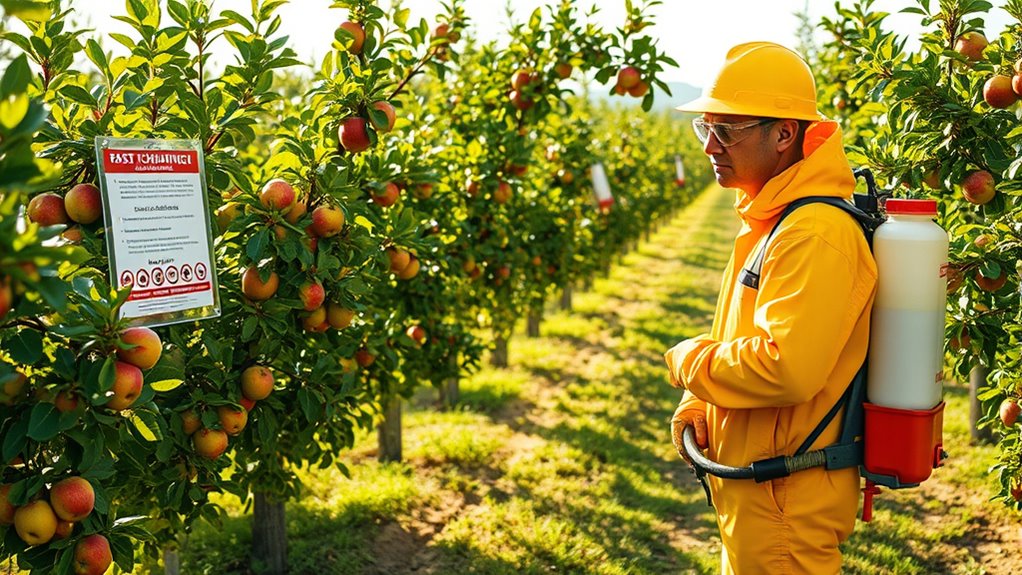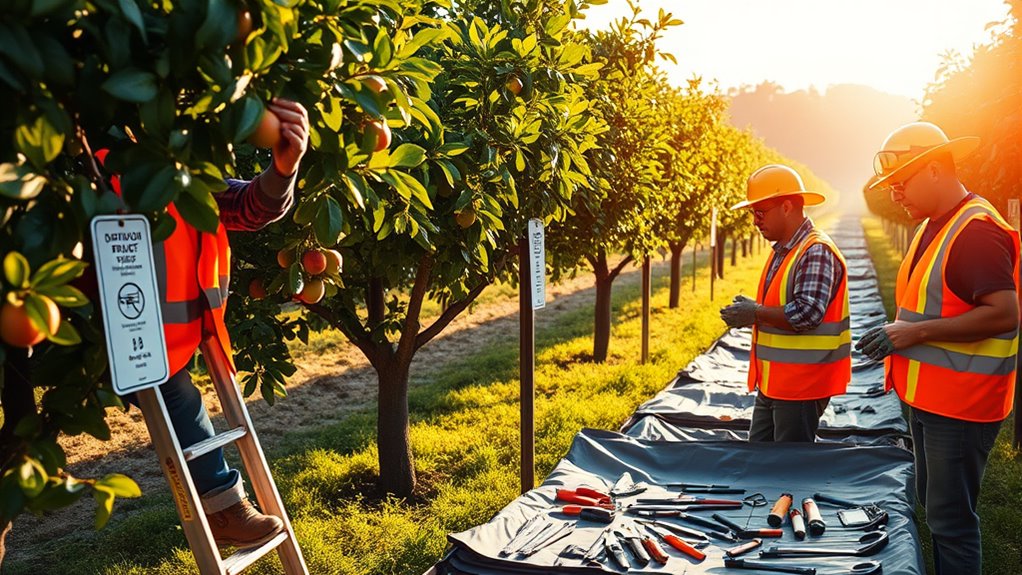To guarantee safety in orchard basics, always wear appropriate Personal Protective Equipment like gloves, eye protection, and sturdy hats. Handle equipment carefully, follow maintenance routines, and inspect tools regularly. Recognize hazards such as falling branches or slippery surfaces and take steps to prevent accidents. Know emergency procedures, keep chemicals stored safely, and communicate hazards clearly with your team. Staying vigilant with these practices helps protect everyone—continue exploring these safety essentials to learn more.
Key Takeaways
- Always wear appropriate PPE, including gloves, eye protection, and high-visibility clothing, when handling chemicals or working at heights.
- Regularly inspect and maintain equipment, following manufacturer instructions to prevent malfunctions and accidents.
- Conduct hazard assessments and monitor orchard conditions to identify and eliminate risks like damaged tools or slippery surfaces.
- Store chemicals safely, use proper disposal methods, and follow label instructions to minimize chemical and pest management hazards.
- Provide ongoing safety training, clear communication, and emergency preparedness plans to ensure a safe orchard environment.
Proper Use of Personal Protective Equipment (PPE)

To protect yourself from potential hazards in the orchard, it’s essential to use personal protective equipment (PPE) correctly. Proper PPE starts with choosing the right gear for each task, so PPE selection is vital. Always wear gloves when handling chemicals or rough branches to prevent cuts and skin irritation. Eye protection, like safety glasses, shields your eyes from debris and chemical splashes. A sturdy hat and high-visibility clothing help keep you safe from falling objects and make sure you’re seen. Make sure your PPE fits well and is in good condition—damaged gear won’t protect you properly. Remember, proper PPE isn’t optional; it’s your first line of defense against injuries. Consistently using the correct PPE keeps you safe and ready to work efficiently in the orchard. Additionally, wearing water-resistant gear can help protect you from unexpected splashes or wet conditions in the orchard environment.
Safe Equipment Handling and Maintenance

Handling orchard equipment safely begins with understanding how to operate and maintain it properly. Regular inspections ensure equipment functions correctly, reducing the risk of accidents and promoting orchard security. Always follow manufacturer instructions and perform routine maintenance, like lubricating moving parts and checking for wear. Proper handling minimizes environmental impacts by preventing leaks, spills, and unnecessary emissions. Use equipment only for its intended purpose, and never bypass safety features. Keep your workspace organized to avoid trips or falls. Training on safe operation procedures boosts your confidence and safety. Maintaining equipment responsibly not only protects you but also preserves the orchard’s environment. Being aware of vehicle tuning options can further optimize equipment performance and safety. When you handle equipment with care, you contribute to a safer, more secure, and environmentally friendly orchard.
Recognizing and Preventing Common Hazards

You need to stay alert for potential risks that could cause injuries or accidents in the orchard. By recognizing hazard signs early, you can avoid injury traps and keep yourself safe. Using safe handling practices is essential to prevent accidents and work confidently. Incorporating awareness of safety trends in footwear can further enhance your protection and comfort during orchard tasks.
Spotting Potential Risks
Recognizing potential risks early is essential for maintaining a safe orchard environment. Start with hazard identification by carefully inspecting your area for anything that could cause harm, like damaged equipment, uneven ground, or exposed wiring. Conduct a thorough risk assessment to evaluate how these hazards could impact you or others. Pay attention to signs of wear on ladders, loose tree branches, or slippery surfaces after rain. By spotting these risks early, you can take proactive steps to prevent accidents. Regularly walking through your orchard and noting hazards helps you stay alert and prepared. Remember, the sooner you identify potential dangers, the easier it is to address them before they cause injuries. Staying vigilant protects both your orchard and your team. Incorporating remote monitoring tools can also help you oversee your orchard conditions more effectively, especially if you manage multiple sites or work remotely.
Avoiding Injury Traps
To prevent injuries in the orchard, it is essential to identify and eliminate common hazards before they cause harm. Recognize the dangers associated with fruit harvesting and pruning techniques. Sharp tools, unstable ladders, and falling branches pose significant risks. Use proper techniques to avoid strain or cuts, and always inspect equipment beforehand. Be alert for uneven ground or hidden obstacles that could cause slips or falls. Implement safety measures such as wearing gloves, helmets, and sturdy footwear. Proper equipment maintenance also plays a crucial role in ensuring safety during orchard work. Here’s a quick overview:
| Hazard Type | Prevention Method | Risk Level |
|---|---|---|
| Falling branches | Use proper pruning techniques | High |
| Slips and trips | Clear debris and uneven ground | Moderate |
| Tool injuries | Maintain and handle tools safely | High |
Stay vigilant and prioritize safety to keep your orchard injury-free.
Safe Handling Practices
Handling orchard tools and equipment properly is key to preventing injuries during harvesting and pruning. Always be aware of the harvest timing, as rushing can lead to mishandling or accidents. Before starting, review the orchard layout to identify potential hazards like uneven terrain or obstacles. Use the right tools for each task, and confirm they are in good condition. Wear appropriate protective gear, including gloves and eye protection. Keep your workspace organized to avoid trips and falls. Be cautious when working at heights, especially near branches that may be unstable. Regularly assess your environment for new hazards, and communicate with team members about safe practices. Proper tool maintenance is essential for ensuring safety and efficiency during orchard work. Following these handling practices minimizes risks and keeps you safe during every phase of orchard work.
Safe Operating Procedures for Machinery and Tools

You need to handle machinery and tools properly to stay safe in the orchard. Always follow the correct procedures for operating equipment, and know how to shut down quickly in an emergency. These steps help prevent accidents and keep everyone safe. Additionally, understanding safety procedures and having clear protocols can significantly reduce risks during orchard work.
Proper Equipment Handling
Ensuring safe operation of machinery and tools is essential for preventing accidents in the orchard. You should always follow proper equipment handling procedures, especially when using tools related to harvesting techniques. Before starting, inspect machinery for damage or defects, and guarantee it’s properly maintained. Keep your workspace organized, paying attention to the orchard layout to avoid tripping hazards or collisions. Use the right tool for each task, and operate machinery at safe speeds. Always wear appropriate protective gear, and never bypass safety features. Stay alert and focused, especially when moving between different orchard zones. Proper equipment handling minimizes risks, keeps you safe, and ensures efficient harvesting. Remember, cautious and correct operation is key to a safe and productive orchard environment. Additionally, understanding safety protocols can further enhance your ability to prevent accidents and promote a secure working atmosphere.
Emergency Shutdown Procedures
In an emergency situation, knowing how to quickly and safely shut down machinery or tools can prevent accidents and reduce damage. First, activate your fire drills to ensure everyone knows the shutdown process. Locate and follow your designated evacuation routes to exit safely if needed. To shut down equipment, turn off power switches or disconnect power sources immediately. If there’s a fire, use fire extinguishers appropriate for the type of fire, and avoid risking personal injury. Always keep clear of moving parts and hazards during shutdown. Practice these procedures regularly so you’re prepared to act swiftly. Remember, staying calm and following established safety protocols helps protect yourself and others during emergencies. Proper training on emergency shutdown procedures is key to overall orchard safety. Attention to your environment and equipment can significantly improve response times and safety outcomes in emergency situations.
Emergency Preparedness and Response Plans

Having a well-designed emergency preparedness and response plan is essential for orchard safety. You need clear evacuation routes mapped out and easily accessible to everyone on-site. Guarantee that all workers know these routes and practice drills regularly. Effective emergency communication is critical; establish reliable methods like radios or loudspeakers to alert staff quickly during an incident. Your plan should include procedures for different emergencies, such as fires or severe weather, and designate roles for team members. Keep emergency contact information updated and visible. By preparing in advance, you minimize confusion and delay during an emergency, helping protect lives and reduce damage. Regularly review and update your plan to adapt to new risks or changes in your orchard layout. Awareness of small mistakes, big impact can help you identify potential oversights in your safety procedures before they occur.
Safe Chemical and Pest Management Practices

To protect workers, crops, and the environment, you must follow safe chemical and pest management practices. Store chemicals properly in a secure, ventilated area away from food and water sources. Regular pest monitoring helps identify issues early, reducing the need for excessive chemical use. Always read and follow label instructions carefully. Use personal protective equipment when handling chemicals. Keep an organized inventory to prevent accidental spills or exposure. The table below highlights key safety practices:
| Chemical Storage | Pest Monitoring | Safe Handling |
|---|---|---|
| Store in labeled, secure containers | Conduct regular pest checks | Wear PPE during application |
| Keep chemicals away from children | Track pest activity patterns | Follow label instructions exactly |
| Ventilate storage areas | Use traps and scouting | Properly dispose of chemicals |
Adopting these practices minimizes risks and promotes a safe orchard environment. Incorporating sustainable practices can further enhance safety and environmental protection.
Training and Communication for a Safer Orchard

Effective training and clear communication are essential for maintaining a safer orchard environment. You should guarantee all workers understand orchard signage, which provides critical safety information and instructions. Regular training sessions help everyone recognize hazards, proper equipment use, and emergency procedures. Emphasize the importance of worker hydration, especially during hot days, to prevent heat-related illnesses. Use simple, visible signage to remind workers to stay hydrated and follow safety protocols. Encourage open communication, so workers feel comfortable reporting hazards or asking questions. Clear, consistent messages reduce misunderstandings and promote safety awareness. By prioritizing effective training and communication, you create a safer workspace where everyone knows how to protect themselves and their colleagues. Incorporating safety protocols into daily routines further enhances overall orchard safety.
Frequently Asked Questions
How Often Should PPE Be Inspected and Replaced?
You should inspect your PPE regularly, ideally before each use, to spot any damage or wear. PPE replacement depends on the condition; replace gear immediately if it shows signs of deterioration, such as cracks, tears, or compromised integrity. Keep an eye on expiration dates for items like helmets or gloves, and follow manufacturer recommendations. Consistent PPE inspection and timely PPE replacement ensure your safety while working in the orchard.
What Are the Signs of Equipment Wear and Tear?
You should look for signs of equipment wear and tear during regular equipment inspections, which are part of your maintenance schedules. Check for cracks, rust, frayed wires, leaks, or loose parts. Listen for unusual noises and feel for excessive vibrations. If you notice any of these signs, it’s time to repair or replace the equipment to guarantee safety and peak performance. Regular inspections help catch issues early before they cause accidents.
How Can Workers Report Safety Concerns Anonymously?
You can easily share your safety concerns through anonymous reporting by using the designated safety concern channels provided by your workplace. These channels guarantee your feedback stays confidential, allowing you to voice worries without worry. Simply follow the instructions for submitting reports, whether online or via a suggestion box. This way, you help keep everyone safe while enjoying peace of mind, knowing your concerns are heard discreetly and taken seriously.
What Are the Legal Requirements for Hazard Signage?
You need to guarantee hazard signage complies with OSHA standards, requiring clear, visible signs that effectively communicate risks. Proper signage aids in hazard identification and enhances signage effectiveness, helping workers recognize dangers quickly. You’re responsible for maintaining signage in good condition, placing it where hazards are present, and updating it as needed. This not only meets legal requirements but also promotes a safer work environment by preventing accidents through clear communication.
How Should Pests Be Safely Integrated Into Pest Management?
Think of pests as uninvited guests in your orchard; you want to manage them without causing harm. To safely integrate pests into your pest management, you should use an integrated pest management plan that emphasizes monitoring and targeted actions. Always prioritize pesticide safety by following label instructions, wearing protective gear, and applying pesticides responsibly. This approach keeps your orchard healthy while minimizing risks to yourself, your team, and the environment.
Conclusion
Remember, safety is your orchard’s guiding star, illuminating the path through every task. By wearing your PPE, handling tools carefully, and staying alert, you become the gardener of a secure, thriving haven. Training and communication are your roots, anchoring your knowledge deep. When emergencies arise, your response is the shield that protects your orchard’s future. Embrace these practices, and your orchard will flourish, a symbol of care and resilience blooming with every safe step you take.










